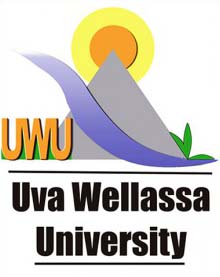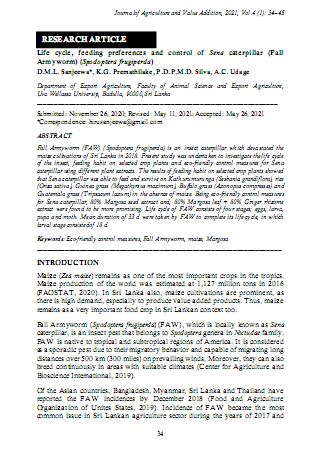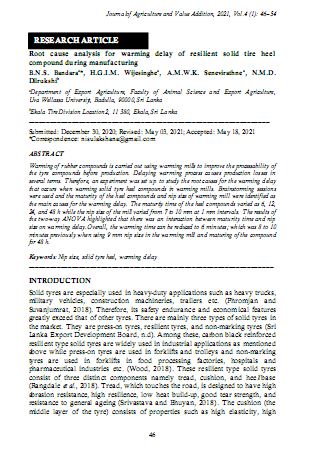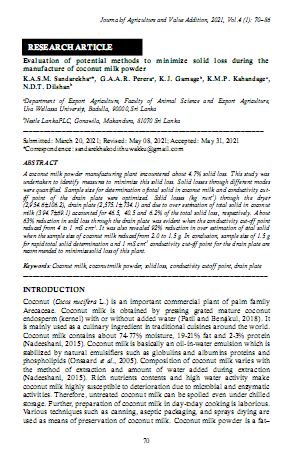
Volume 04 Issue 02
RESEARCH ARTICLES
01. Development of ready-to-eat canned fish using rainbow runner (Elagatis bipinnulata) with different filling materials
D.W.N. Sathsarani a, Tharindu Bandara a*, K.E. Udayathilaka b, E.D.N.S. Abeyrathnea
a Department of Animal Science, Faculty of Animal Science and Export Agriculture, Uva Wellassa University, Badulla, 90000, Sri Lanka
b Happy Cook Lanka Food (Pvt.) Ltd, Galle, 80000, Sri Lanka
INFORMATION
Journal Title: Journal of Agriculture and Value Addition
Volume : 4 Issue 02
Page : 1- 12
Submitted: January 21, 2021; Revised: March 01, 2021; Accepted: July 05, 2021
* Correspondence: tharinduacademia@hotmail.com
ABSTRACT
Fish is widely considered as one of the perishable food items and increasing fish shelf-life is important for avoiding post- harvest losses. The objective of the present study was to develop a ready-to-eat canned fish product using readily available relatively cheaper fish: Rainbow runner (Elagatis bipinnulata). The matured Rainbow runner with an average weight of 4.2 kg was utilized in preliminary trials to find out the best spice levels and filling solutions. These preliminary canned fish products were sensory evaluated with 30 untrained panelists. Based on sensory evaluation, the best filling solutions were selected to prepare the final canned fish products. These final canned fish products were sterilized at different sterilization periods (121 °C: 50, 65, 70 and 75 min). Subsequently, these final products were sensory analysed for finding the best sterilization period using the previous sensory panelists. Finally, fish products with the best filling solutions and the best sterilization period were subjected to keeping quality analysis (pH, lipid oxidation, antioxidant activity and microbial count) for 30 d and proximate analyses. Preliminary sensory analysis revealed that soy sauce and tomato sauce were the best filling solutions. Sensory analysis of the final product indicated 65 min. of sterilization period was best for fish products in both filling solutions. The proximate composition of protein, lipid and ash of the final products were relatively higher than the comparable canned products in the market. Keeping quality analyses of final products have indicated that canned products were free from E. coli and Salmonella. Lipid oxidation and total plate count were within the acceptable levels (Thiobarbituric acid reactive substance assay (TBARS) <3 mg MDA/kg and <105 cfu/g, respectively). Antioxidant activity measured in terms of DPPH (2,2-diphenyl-1- picrylhydrazyl scavenging activity was high (>60%) in both products. The present study revealed that the canned Rainbow runner in soy sauce and tomato sauce can be a preferable product up to 30 d of storage period and a suitable alternative to other canned fish products in the market. Further, nutritional evaluation of these products (E.g. fatty acid analyses) and keeping quality analyses over a longer period can be recommended subject to further studies.
Keywords: Canned fish, keeping quality, lipid oxidation, rainbow runner, sensory analysis
02. Challenges in tomato cultivation and marketing: a thematic analysis.
Grace H. Hensman*
*Faculty of Management Studies and Commerce, University of Jaffna, 40000, Sri Lanka
INFORMATION
Journal Title: Journal of Agriculture and Value Addition
Volume : 4 Issue 02
Page : 13- 25
Submitted: July 03, 2021; Revised: October 12, 2021; Accepted: November 01, 2021
* Correspondence: grace_hensman@univ.jfn.ac.lk
ABSTRACT
This paper aims to identify the challenges in the cultivation and marketing of tomatoes and the marketing mechanisms for the surplus production of tomatoes. This paper uses in-depth interviews with twenty-eight farmers and nine agricultural officials in different parts of Jaffna district. Focus group discussion was conducted to explore themes; six sub-themes were identified under two broad themes. Climatic changes, Modern technology adaptation, price fluctuation, and institutionalized policy, product diversification, and systematic marketing mechanisms were the identified sub-themes in this research study. Different strategies to overcome the climatic changes should be developed. As observed, local level adaptation and farm management system should be adapted in tomato farming system. Creation of an economic center in the region is very useful in order to avoid price fluctuations and losses faced by the farmers. Government should make policies to put up a processing center which in turn will give many employment opportunities for the youths and tomato farmers in the region
Keywords: Challenges, marketing mechanisms, themes, tomato cultivation
03. Assessment of different pickling solutions on quality characteristics of pickled quail (Coturnix coturnix japonica) eggs
M.G.N.W.W. Gunathilaka, T.I.G. Prabashwari, H.W. Cyril, S.M.C. Himali*
a Department of Animal Science, Faculty of Agriculture, University of Peradeniya, Peradeniya, 20400, Sri Lanka
INFORMATION
Journal Title: Journal of Agriculture and Value Addition
Volume : 4 Issue 02
Page : 26 – 43
Submitted: July 06, 2021; Revised: October 17, 2021; Accepted: October 23, 2021
* Correspondence: *himali.samaraweera@gmail.com
ABSTRACT
The study was conducted to determine the influence of different pickling solutions on the quality characteristics of pickled quail (Coturnix coturnix japonica) eggs. Quail eggs were pickled in seven different pickling solutions (Dill, Mustard, Garlic, Rosy, Simpal, Marion’s and British PU) and stored for 28 d at room temperature. Four pickling solutions (Dill, Mustard, Garlic and Rosy) were selected according to results of sensory evaluation and some modifications were done as per the comments of the sensory evaluation. The pickled egg quality from modified four pickling solutions and the control were evaluated weekly during storage. As per the observations, color and tenderness of egg white were significantly (P<0.05) different during the storage. The control and the Rosy pickle had better consumer acceptability. The Rosy pickled eggs contained 65.30±0.04% moisture, 10.42±0.12% crude fat and 13.16±0.08% crude protein. Thus, it can be introduced as a preserved product.
Keywords: Egg white, hard-cooked, pickling, quail eggs, quality
04. Effect of microwave heating or simple heat (pan roasted) treatment of rice bran on the rate of release of free fatty acids during storage at room temperature
W.A.D.V. Weerathilakea*
a Department of Livestock and Avian Science, Faculty of Livestock Fisheries and Nutrition, Wayamba University Sri Lanka, Makandura, Gonawila (NWP), 60170, Sri Lanka
INFORMATION
Journal Title: Journal of Agriculture and Value Addition
Volume : 4 Issue 02
Page : 44 – 56
Submitted: October 19, 2021; Revised: November 02, 2021; Accepted: November 13,2021
* Correspondence: dammika_kandy@yahoo.com
ABSTRACT
Development of Free Fatty Acids (FFA) is a major problem which affects the use of rice bran as a feed ingredient. The purpose of this research was to evaluate the effect of microwave heating and pan roasting on FFA development of rice bran during storage, proximate composition and to study the available phosphorous (P) content. Rice bran from raw and parboiled rice obtained from paddy variety BG 358 was treated using microwave heat and pan roasting. An experiment was conducted in a two-factor factorial with 2×3 factorial design. Treated samples were studied for FFA content up to 8 weeks in weekly intervals. Proximate composition was studied immediately after heat treatment and at the eighth week. Availability of P in rice bran was studied after heat treatment. Both the treatments significantly reduced the formation of FFA in rice bran during storage (P<0.05), while microwave heat treatment showed a higher effect on reduction of the formation of FFA content in raw microwave heated rice bran from 2.68 to 12.44 g 100 g ˗1 and in parboiled microwave heated rice bran from 1.8 to 9.54 g 100 g˗1 during eight weeks of storage. There was no significant (P>0.05) difference in proximate composition of rice bran during the period of storage in any of the treatments. Both treatments improved P availability; however, pan-roasting had a high effect on P availability where raw pan roasted rice bran and parboiled pan roasted rice bran showed an increment of 17.67 and 19.43%, respectively. It is concluded that pan roast and microwave heat retard development of rancidity in rice bran, although at different degrees. These findings could be used with suitable modifications to the milling and storage processes to improve the quality of the rice bran available for animal feeding in Sri Lanka.
Keywords: vailable phosphorous (P), FFA, microwave heating, pan roasting, rice bran
05. Food habits of Pterygoplichthys disjunctivus (Vermiculated sailfin cat fish) and coexisting fish species in Victoria and Kalawewa reservoirs, Sri Lanka
I.U. Wickramaratnea*
a Department of Animal Science, Faculty of Animal Science and Export Agriculture, Uva Wellassa University, Badulla, 90000, Sri Lanka
INFORMATION
Journal Title: Journal of Agriculture and Value Addition
Volume : 4 Issue 02
Page : 57 – 75
Submitted: September 24, 2021; Revised: October 23, 2021; Accepted: November 16, 2021
* Correspondence: indikau@uwu.ac.lk
ABSTRACT
Pterygoplichthys disjunctivus is now recognized as an invasive alien species (IAS) in Sri Lanka. This species has established populations in local water bodies including Victoria and Kalawewa reservoirs. Current study aims to find out food habits of P. disjunctivus. Fish samples of P. disjunctivus and coexisting fish species were collected from Victoria and Kalawewa reservoirs in the months of August and September in 2018, respectively, with prior permission and their total length, standard length and weight were recorded to the nearest 0.1 cm and 0.1 g, respectively. Relative importance of food items, Pianka’s food niche overlapping index values were analyzed in the study. Relative importance of food items of P. disjunctivus, Oreochromis niloticus and Etroplus suratensis show similar values for both reservoirs illustrating similar food preferences and omnivorous feeding habit. Diets of Rasbora daniconius, Glossogobius guiris, Mystus vittatus and Heteropneustes fossilis consisted of more insects and fish particles in both reservoirs indicating a carnivorous feeding habit including Mastecembelus armatus. Diets of Puntius filamentosus (Dawkinsia filamentosa) and Puntius chola consisted mainly with plant particles showing that these species are macrophyte feeders which were caught from Victoria and Kalawewa reservoirs. Pianka’s food niche overlapping index values for the diets of O. niloticus, E. suratensis, with P. disjunctivus in both reservoirs showed high overlapping values indicating high dietary overlap but G. guiris, M. vittatus, H. fossilis, P. filamentosus, R. daniconius, P. dorsalis and P. chola with P. disjunctivus in Victoria reservoir showed low overlapping values indicating relaxed dietary overlap. Pianka’s food niche overlapping index values for the diets of G. guiris, M. vittatus, H. fossilis, P. filamentosus, R. daniconius, and P. chola with P. disjunctivus showed low overlapping values indicating low dietary overlap in Kalawewa reservoir. Pianka’s food niche overlapping index values revealed P. disjunctivus is in competition with food habits with O. niloticus and E. suratensis. Therefore, suitable fishing gear or trap should be identified for effective controlling of P. disjunctivus in Sri Lankan water bodies.
Keywords : Pterygoplichthys disjunctivus, invasive species, food overlapping
06. Key determinants of milk production in dairy farms of Jaffna district, Sri Lanka
K. Arthikaa, W.A.D.V. Weerathilake a*
a Department of Livestock and Avian Sciences, Faculty of Livestock, Fisheries and Nutrition, Wayamba University of Sri Lanka, Makandura, Gonawila (NWP) 60170, Sri Lanka
INFORMATION
Journal Title: Journal of Agriculture and Value Addition
Volume : 4 Issue 02
Page : 76 – 88
Submitted: November 25, 2021; Revised: December 14, 2021; Accepted: December 25,2021
* Correspondence: dammika_kandy@yahoo.com
ABSTRACT
Dairy farming has tremendous potential in the economy of the Jaffna district. However, the dairy farms of the district were incompetent to cater to the demands. Therefore, this study investigated the factors determining milk production in dairy farms of the Jaffna district. A total of 150 farms were selected using a stratified and simple random sampling technique. Milk production and socio- economic data were collected using a structured questionnaire covering randomly selected 5 Veterinary Surgeon Divisions. Data were analysed for descriptive statistics followed by multiple linear regression analysis. Results of the descriptive statistical analysis of demographic data showed that 38.6% of farms were under semi-intensive, 37.3% were under intensive management systems and the rest of 24% were under an extensive management system. Further, 65.3% of animals were Jersey crosses, while 22.6% were local breeds and 12% of animals were Sahiwal crosses. About 75% of the farmers were feeding their dairy animals with roadside grasses and only 25% were feeding with quality forages. The average milk production per animal per day was 3.14 L. The best fitted multiple linear regression model predicted that R2 value of 92.05% daily milk production suggesting that experience of farmers, frequency of drinking water supply, frequency of feeding concentrate, amount of concentrate given (kg d˗1), amount of mineral supplement given (g d ˗1) and types of management system were significantly (P<0.05) affected the daily milk production of Jaffna district. It is suggested that the dissemination of knowledge regarding these key- determinants of milk production is crucial for the improvement of milk production from the Jaffna district.
Keywords : Milk production, key-determinants, Jaffna district, regression






